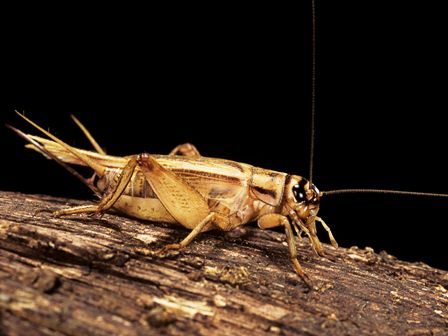Crickets fall under the Phylum Arthropoda and class Insecta. Though they look like grasshoppers, they have few differences. Cricket has a longer antennae than a grasshopper. Crickets sing by rubbing their wings against each other while the grasshopper sing by rubbing their wings with the long hind legs.
They are found in different habitats, some live in the high canopy, some in bushes, and some on the ground. They make a peculiar sound from their wings by rubbing against each other.
Crickets are also eaten as delicious snacks in some South Asian countries. You may find roadside vendors selling fried crickets with salt and pepper in Thailand.
We came to know how crickets are eaten in different countries. But, what do crickets eat? Crickets are omnivorous, they mostly eat rotten leaves, fruits, and sometimes other insects too alive. They do not drink water directly. They get their required water from moisture present in their food materials.
Here’s a closer look at what crickets eat and drink:
- Plant Material: Crickets are known to feed on a variety of plant materials, including leaves, fruits, flowers, and vegetables. They can be particularly destructive to crops in agricultural settings.
- Decaying Matter: Crickets are scavengers, and they often feed on decaying organic matter, such as dead insects, fallen leaves, and rotting wood. This helps them recycle nutrients in their ecosystem.
- Small Insects: While crickets are primarily herbivorous, they are opportunistic predators and will consume smaller insects when the opportunity arises. They may hunt and eat other insects, such as aphids, small caterpillars, and mites.
- Fungi: Crickets have been observed feeding on various types of fungi, including molds and mildews. Fungi can provide essential nutrients and moisture to their diet.
- Carbohydrates: Crickets require carbohydrates for energy, and they obtain these from sources like nectar, pollen, and sap from plants.
When it comes to their hydration needs, crickets primarily obtain water from their food sources. They are also known to drink from dewdrops on leaves and other available sources of moisture. In captivity, providing a water source is essential for their well-being, typically through a shallow dish with water or a sponge. It’s important to keep the water source clean to prevent bacterial growth.
In summary, crickets are adaptable feeders, consuming a diverse range of foods in their natural environment. They are opportunistic eaters and will consume what is readily available. In captivity, they should be provided with a balanced diet that includes plant material and a water source to ensure their health and longevity.
Ankurman Handique
Latest posts by Ankurman Handique (see all)
- How to Reach Kaziranga National Park: A Complete Guide - June 29, 2024
- What animals are found in Puerto Rico? - February 23, 2024
- What does coyote poop look like? - February 20, 2024

